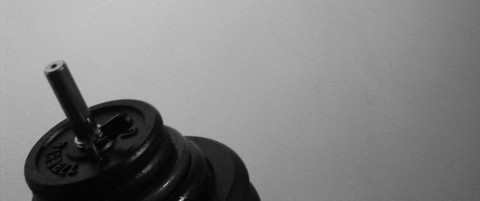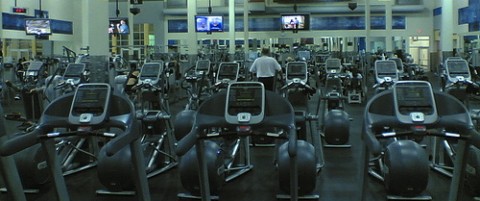
Do you think you need spend six hours in the gym every week to get the results you want?
Or that you need to work every muscle group in isolation to failure once or twice a week?
Or maybe you think you need fancy equipment, expensive classes, and complex supplements to lose fat and build muscle?
If the answer to any of these questions is “yes,” then you probably have a case of exercisitis, a terrible affliction that has been spreading around the globe for decades.
Exercisitis is a disease that causes its sufferers to spend too much time exercising, to the point that it starts to affect the rest of their lives negatively.
And there is only one known cure: to renounce their former ways and embrace a new path.
The path of minimalism.
The Zen of Exercise
Over the past few years, I’ve become more and more interested in the concept of minimalism.
Instead of constantly striving to increase the complexity in your life, you instead focus on eliminating distraction and focusing instead on what really matters.
Instead of quantity, you focus on quality.
While I’m by no means an expert in this area, I have found that it has improved my life, and one example is in the way I approach exercise.
Gone are the days of spending endless hours a week in the gym; doing a million variations of crunches, curls, and chest presses.
Instead, my routine is centered on compound movements, full-body workouts, and high-intensity exercises.
Here’s a primer to start you on your own minimalist fitness path.
Quality, Not Quantity of Movement
The second pillar of our philosophy is “Move Smarter,” which can be broken into three chunks:
- Move Your Body– No matter what you are doing, moving more is better than sitting still. But moving your body the way it was meant to is at all times more efficient than most of the insignificant, unproductive, and just plain bizarre fitness routines most people follow.
- Don’t Overdo It– Most people with an interest in fitness are frankly overdoing it, if for no other reason than it is getting in the way of things in their lives that are more important. But it doesn’t stop there. The obsession with increasing weight, reps, and sets often comes at the expense of form, which leads to injury.
- Have Fun– Conventional wisdom states that exercise is man’s punishment for having a body that wants to gain weight regardless of context. Nonsense! You should be doing physical activities that are fun if you are ever going to stick with it.
The Three-Hour Rule
If you’re struggling to get the results you want from working out, you should focus less on what you should start adding and more on what you should start taking away.
Hammer curls? Bent-over rows? Wrist curls? Waste of time. Get in some pull-ups and get out.
Cable crossovers? Triceps kickbacks? Dumbbell lateral raises? Fuhgeddaboudit! Get in some push ups and get out.
Leg extensions? Hip abductions? Calf raises? Don’t bother! Get in some squats and get out.
It’s crazy how many exercise routines out there are focusing on minutiae at the expense of the big picture.
All that advice out there to isolate every muscle group in isolation and exhaust once or twice a week? It gives great results… If you are a bodybuilder and need to work out a few hours every day in order to see very small changes.
But if you are that person, you are reading the WRONG website.
If you’ve got a job to deal with, or school, you’re going to need more bang for your buck. If you like to spend time with friends and family, you’re going to need to find something better. And if you frankly have bigger things going on in your life than reaching 3% body fat, you need a new set of rules.
Unless you are someone whose livelihood is dependent on your appearance or fitness level, you should not spend more than three hours each week working out.
Three hours is the absolute ceiling. Two hours will work for most people, and the super-dedicated will be able to squeak by in an hour.
The “catch” here is that the foundation of your exercise routine should lie outside the gym, and it doesn’t count towards your three hours.
You need to become more physical in your everyday life. Start walking places instead of driving. Take the stairs rather than the elevator, and find some fun physical activity to do at least once a week.
You can get into very good shape without ever having to count a rep or set, and you should try to make this your goal as much as possible.
Think of “working out” instead as the brief amount of time you spend each week doing the kinds of intense movements that you won’t otherwise do, exercises that will give you the most bang for your buck and leave you in great shape as a result.
Minimalist Equipment–The Gym vs the Basement
This is the exact opposite of minimalist fitness:

…yet it is what most of us think is necessary in a gym.
If your goal is to use the absolute minimum of equipment, you can often get away with having a small home gym with just a few pieces of gear. Here are some that I’d recommend:
- A barbell set (if you have the room) or a kettlebell
- A pull-up bar
- A jump rope
- A good pair of running shoes
Seem like it’s not enough?
Most people could get by with that and never have to worry about getting a gym membership ever again.
At the same time, gyms can offer you one of the biggest wins of all: you don’t have to own any exercise equipment of your own. You can just pay to use someone else’s.
Just make sure you ignore all the machines that look like something Drago from Rocky IV would have used.
Both of these ways are minimalist. Just don’t get too carried away.
The Illusion of Muscle Failure
So exactly how should you train?
Conventional wisdom would have you push yourself to complete failure on every set. And conventional wisdom is wrong here.
This might be decent advice if you are safe and sound on a piece of equipment that simulates bicep curls, but what if you’ve got a lot of weight in your hands while you’re doing squats, cleans, or bench presses?
In that case, “working to exhaustion” is rolling the dice. You’ll eventually end up injuring yourself. And you’ll be in no better shape than if you had stopped one or two reps earlier.
Instead of focusing on how many reps at how much weight you can crank out, instead focus on pushing yourself as hard as you can, until your form is no longer perfect.
People get injured when they try to move too much weight with shitty form. By starting with low weights and perfecting your form, you can gain strength and muscle without having to worry about tweaking your back (or anything else).
Besides, the concept of “muscle failure” is slowly being exposed as less of a physical limitation and more of a psychological one. Interesting stuff.
The Distraction of Supplements
Supplements are 99% scam.
We’re told that they are necessary to get into great shape. But again, unless you are a bodybuilder, powerlifter, or competitive athlete, you will not get your money’s worth out of them.
For the rest of us, there’s no need to drink awful shakes or try to remember to take pills every day. Eating real food is enough.
Save your money for food, not pills.
I’ve filled this site up with practical info on how to eat better and controversial theory on why it is so much more important, so I’ll leave it at that here, but feel free to go searching around the site if you’d like to learn more.
The Minimalist Path
It’s easy to think you need to become a gym rat in order to lose fat and build muscle. After all, it’s what we’ve always been told.
Unfortunately, we’ve been told this by people whose livelihoods depend on how much weight they can lift, how little body fat they have, and how good they look nekkid.
You are not this person.
You’ve got bigger dragons to slay. And looking and feeling good is merely a means to that end.
It’s a great idea to dedicating yourself to looking and feeling great, but you need not go to the extremes that the pros do. Doing so would just lead to a bad case of exercisitis.
By stripping away the noise and focusing on the big wins, you can reap 80% of the reward with only 20% of the effort.
This is the Zen of minimalist exercise. And it is by far the sanest and healthiest way to incorporate physical activity into your life.
 I'm a science geek, food lover, and wannabe surfer.
I'm a science geek, food lover, and wannabe surfer.
{ 1 trackback }
{ 1 comment }
Darrin,
I totally agree with your philosophy on exercise. I try to spend no more than 1-2 hours on formal exercise per week and at least a few more hours of leisurely physical activity which is fun.
Alykhan
Comments on this entry are closed.